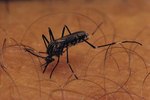Noah took animals on his ark by twos, but ticks must have brought relatives along. More than 840 species of ticks have been identified worldwide, while researchers continue to find new species globally. Ticks are blood-sucking parasites classified in two families: hard ticks (Ixodidae) and soft ticks (Argasidae). They spread varieties of diseases to animals and humans. Ixodidae is the larger family of ticks and contains the tick species bearing one white spot on the back.
Tick Biology
John Anderson, an emeritus scientist with the Connecticut Agricultural Experiment Station, called ticks "the most significant blood-sucking arthropods worldwide." Ticks extract blood from animal or human hosts using hard, harpoonlike structures near their mouths called hypostomes, which allow the ticks to anchor themselves while they feed. Soft ticks feed within hours and merely take blood. Hardbacked ticks consume for days, Anderson wrote, and feed on blood, lymph and tissues. Call them give-and-take parasites, since during the course of feeding, the tick takes blood and leaves diseases behind.
Lone Star Tick
In the spring of 1942, more than 1,000 soldiers stationed at Camp Bullis, Texas, became ill with flulike symptoms: high fevers, headaches, nausea and overall weakness. Some of them had ticks attached to them when they went to seek medical help. The ticks were lone star ticks (Amblyomma americanum), parasites first described in the United States in 1754. The ticks were abundant in Texas. In 1943, one entomologist wrote that four men collected 4,086 adult ticks in one day without moving. The ticks got their name because of the single silvery-white spot that the female of the species has in the middle of her back.
Lone Star Ticks and Disease
Despite the documented illnesses at Camp Bullis in 1942, for more than 40 years, lone star ticks were considered nothing more than nuisances. In the early 1990s, research confirmed that lone star ticks -- nymphs and adults -- were transmitting diseases to animals and humans. Four human infections associated with lone star ticks are human monocytic ehrlichiosis, Rocky Mountain spotted fever, tularemia and southern tick-associated rash illness.
Identifying Lone Star Ticks
Lone Star ticks develop from eggs. The larvae, nymphs and adults have the same body shape but differ in size. Larvae, called seed ticks, have six legs and are active from July to mid-September. Nymphs are double the size of the larvae, have eight legs and are active from May to early August. Adults measure one-third of an inch in length and grow to a half-inch after engorging on blood. Adults feed from April to late August. The adult male does not have a white spot on his back like the adult female; he has scattered spots around the edges of his body. These ticks live in the dense underbrush of second-growth forests.
References
- Medical Clinics of North America: The Natural History of Ticks
- Practical Science: Practical Parasitology: Introduction to the Hard Bodied Ticks and Lyme Disease
- Annual Review of Entomology: The Ascendency of Amblyomma Americanum as a Vector of Pathogens Affecting Humans in the United States
- Texas A&M Agrilife Extension: Lone Star Tick
- University of Rhode Island: TickEncounter Resource Center: Amblyomma Americanum: Lone Star Tick
- Encyclopedia of Life: Amblyomma Americanum: Lone Star Tick
Resources
- Department of Entomology: University of Wisconsin-Madison: Wisconsin Ticks and Tick-Borne Diseases: Amblyomma Americanum: Lone Star Tick
- Centers for Disease Control and Infection: Ticks: Geographic Distribution
- BugGuide: Family Ixodidae: Hard Ticks
- Current Topics in Microbiology and Immunology: Ecological Havoc, the Rise of White-Tailed Deer, and the Emergence of Amblyomma Americanum: Associated Zoonoses in the United States
- Established Amblyomma Americanum Tick Populations Centers for Disease Control and Protection: Map of Amblyomma Americanum





